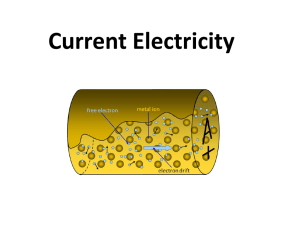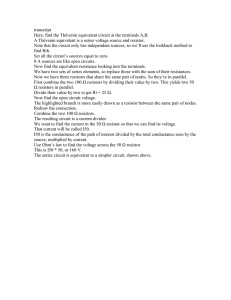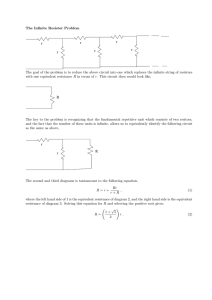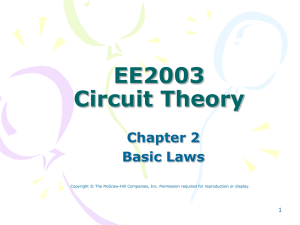Current Electricity Q C
advertisement
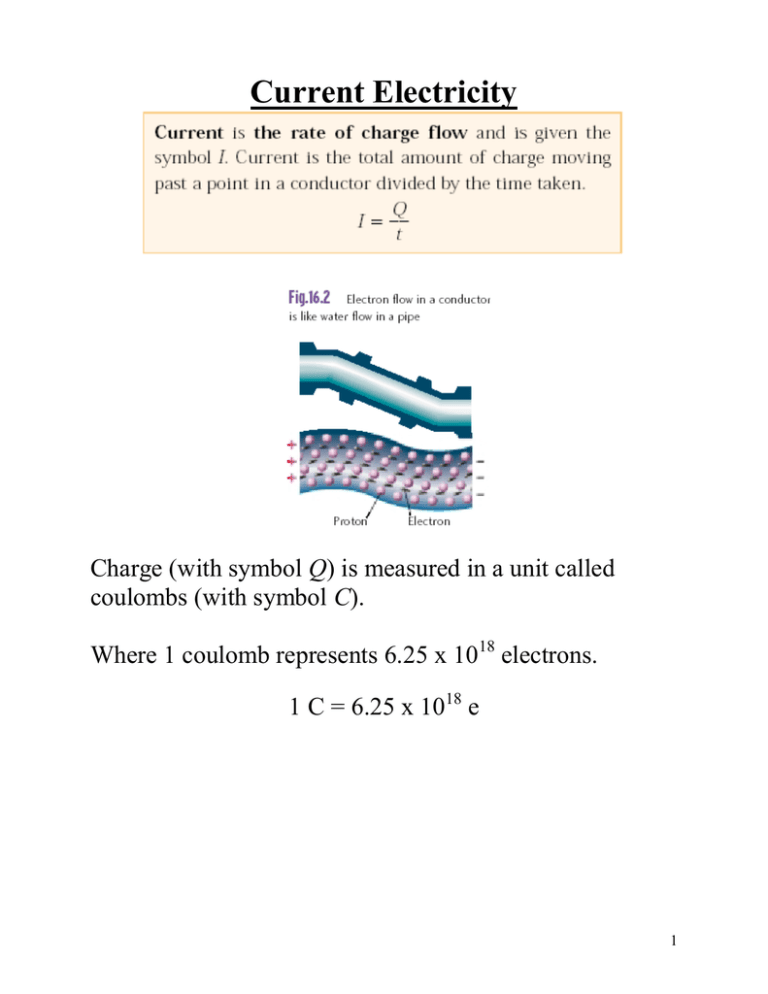
Current Electricity Charge (with symbol Q) is measured in a unit called coulombs (with symbol C). Where 1 coulomb represents 6.25 x 1018 electrons. 1 C = 6.25 x 1018 e 1 Direction of Current Flow Current involves a flow of negatively charged electrons repelling one another. Historically, current flow was thought to move from the positive (+) terminal to the negative (-) terminal of any power supply. The model of positive charge flow is called conventional current and will be used in the study of electromagnetism. It was thought that the positive terminal of a simple battery had an excess of electricity and the negative terminal had a deficit of electrons. From this perspective, it only made sense that current flowed from a positive to a negative region. Measuring Current Current is measured with an ammeter that must be wired in series. 2 Circuit Symbols 3 Electric Potential 4 Measuring Electrical Potential A voltmeter must be connected in parallel with a load in the circuit in order to compare the potential before and after the load. 5 Table 16.2 Sources of Electrical Energy Source process Common applications Voltaic cells Chemical potential energy is released during a reaction as electrons are driven between two different metals. E.g., common dry cell batteries for portable electric devices Piezo-electricity Quartz and Rochelle salt crystals create small electric potential when mechanical force or stress is applied to them. E.g., phonograph cartridges, barbecue spark starters Thermoelectricity Two pieces of different metals joined together and subjected to temperature differentials transfer thermal energy to electric potential energy in what is called a thermocouple. E.g., gas appliance pilot light safety system: current keeps gas valve open as long as flame is lit Photo electricity Light energy absorbed by electrons of certain metals causes charge flow. E.g., satellite and international space station power supply, calculator power supply Electromagnetic Kinetic energy of water or steam forces conductors to rotate in a induction in generators magnetic field. (see Chapter 18) E.g., hydro-, nuclear-, fossil-fuel-powered electric generators The measure of this opposition to flow is called electrical resistance. 6 7 8 In a series circuit, the loads are connected one after another in a single path, whereas in a parallel circuit, they are side by side. 9 10 11 Rules and Strategies of the Circuit Analysis Game 1. Fill in all known quantities in the table provided (Score Card). Fill in any “buried” known quantities. These quantities are the ones you can assume at a glance from Kirchhoff’s laws, like the fact that any resistor in line with IT has the same value. 2. Reduce any parallel element to a series equivalent.V1 3. Draw the circuit as a series-equivalent circuit (Fig. 16.19). Calculate the total resistance of the circuit by adding all resistors in the series equivalent (if all individual resistances are given). 4. Use V _ IR to find any missing variable if you are given any two out of three parameters in a row. We now have a VT and an RT. 5. According to Kirchhoff’s current law, all series resistors have the same current, 6. If you have two out of three knowns in a row on the score card, 7. Voltages (Kirchhoff’s voltage law for series and parallel circuits) Here, V2 =V3 by Kirchhoff’s voltage law. The sum of all individual voltages must equal the total voltage. 8. Two out of three known quantities in a row. Check after every step. You just won the game! You can be sure by going back and double-checking the answers on the score card. Other strategies that you could use 1. Current splitting (with parallel elements): If the current that is entering the parallel resistors (usually the total current, IT) and the resistor values are known, try this method to see how the current is split between the two resistors. The resistance ratio for any resistor is resistance of that load divided by the sum of both resistors 2. Series-equivalent resistors: Find the voltage drop across any parallel element by using the series equivalent resistance and the total current. 12 Recall that power is the rate at which work is done. 13 The Cost of Electricity Cost Energy in kWh x (Rate) Cost Power (kW) x time (h) x Rate The cost of a 100 W light bulb on for 10 hours at a rate of 4.7 cents/kWh would be : Cost 0.100 kW x 10 h x $0.047 $ 0.047 or 4.7 cents 14






